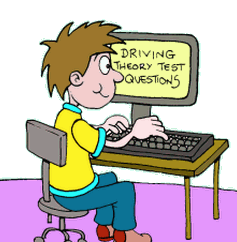Driving Theory Stopping Distances
Stopping distances refer to the distance that you car is going to travel from the time that you decide that you need to press the brake through the time that the vehicle physically stops moving.
Now there are two things that clearly influence what the stopping distance is going to be. Those two elements are your reaction time, and secondly the speed at which you are moving, which is quantified by something called the braking distance.
As you would expect, the stopping distance is increased the faster you are travelling, because there is more speed to reduce and also the further you travel during the time that it takes you to react.
Thinking in metres travelled versus a speed in miles per hour (mph) a simple table can be created that tells you what the stopping distances are for a given speed.
Stopping distances are important because you need to ensure that you drive at a speed that will allow you to stop well within the distance you can see to be clear and leave enough space in front of you to allow you to stop safely if inecessary.
This table shows you the stopping distances for speeds from 20mph up to 70mph.
| Speed |
Overall stopping distance |
| 20 mph
|
12 metres |
| 30 mph
|
23 metres |
| 40 mph
|
36 metres |
| 50 mph
|
53 metres |
| 60 mph
|
73 metres |
| 70 mph
|
96 metres |
Related Articles...
Your vehicle's age is important
The age of your car is important for several reasons.
The main reason is that if your car is under three years old, there are four documents that you must be in possession of in relation to...
Your ignition system explained
The ignition system is of course an essential part of the technology that allows cars to function, and without it you would not get very far. But what does it do? Well the system provides the...
Tips on driving with a heavy load
When you have passed your test and been driving for a while, you might find yourself driving with a heavy load.
For instance if you are going on holiday then you might have lots of stuff that...
The Advanced Driving Test
There are advantages to continuing to study driving by means of a course like the advanced driving test, because it will help to give you the chance to develop your skills even further than you had...
Driving and mobile phones
Some people are confused about the rules about using a mobile whilst
driving, whilst others know the rules and break them. You might see other
people driving with a phone to their ear but you...
More on Motorway Driving
Signs that let you know there is a motorway ahead are rectangular, and they have a green background. This shows that they are information signs on a primary road.
The part with the reference...
How to help yourself stay safe whilst driving
It is a sad fact, but a fact nonetheless, that there are very rare occasions on which you can just get unlucky and be involved in an accident, whether minor or major, that you are powerful to do...
Tips on braking on snow and ice
Braking on snow and ice takes a lot longer than it does on a normal road in ordinary conditions. But you might be very surprised at how long it can take.
Infact tests have shown that it can...
Your car and the lights on it
We are all used to seeing cars in the dark, and also seeing their indicators in the day to communicate to other car drivers. But what must you ensure with regard to the lighting of your...
Vulnerable road users - pedestrians
Pedestrians whether old or young are all potentially vulnerable. Any impact at all on a pedestrian is potentially fatal, and that goes for a pedestrian of any age.
Of course within the class...
Back to home page of driving theory test questions

